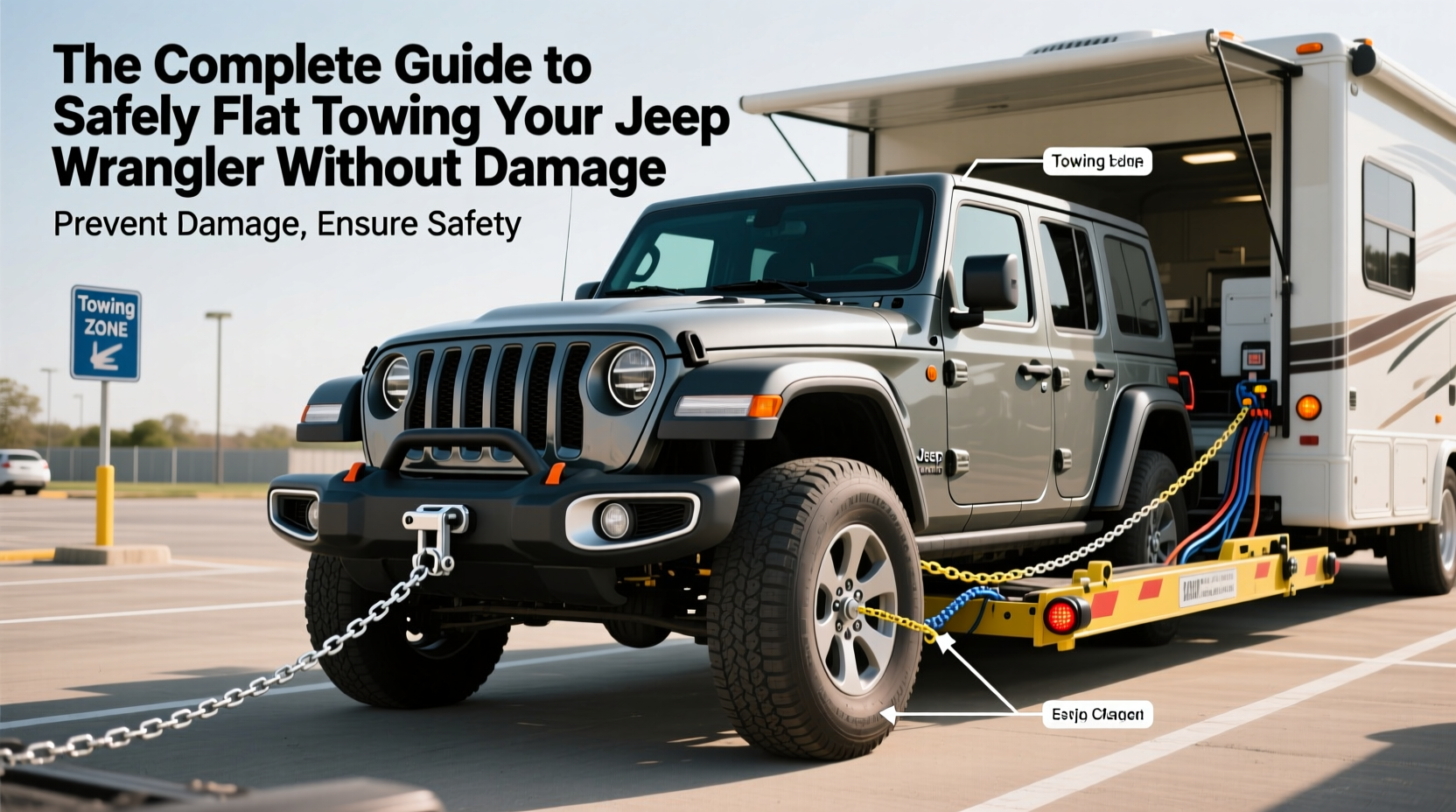Flat towing—a method where all four wheels of a vehicle remain on the ground while being pulled by another vehicle—is a popular choice among RV travelers and off-road enthusiasts. For Jeep Wrangler owners, this capability is one of the brand’s standout features. However, doing it incorrectly can lead to serious transmission, transfer case, or drivetrain damage. Understanding the correct procedures, equipment, and model-specific requirements is essential to ensure your Wrangler arrives at its destination unscathed.
Understanding Flat Towing and Your Jeep Wrangler

Not all vehicles are designed to be flat towed, but most Jeep Wranglers are engineered with this in mind—especially models from 2007 onward. The key lies in the transfer case. When in neutral, certain Wrangler transfer cases allow the rear driveshaft to spin freely, preventing transmission damage during towing.
However, newer models with electronic transfer cases (such as the JL generation introduced in 2018) may require additional steps or even special kits to enable safe flat towing. Always consult your owner’s manual before assuming your specific model supports this method.
“Flat towing is a convenience, not a given. Each Jeep model year has nuances that must be respected to avoid costly repairs.” — Mark Reynolds, ASE-Certified Technician and Off-Road Vehicle Specialist
Step-by-Step: How to Safely Flat Tow Your Jeep Wrangler
Safety begins long before you hitch up. Follow this detailed sequence to prepare your Wrangler for flat towing:
- Verify Towing Compatibility: Confirm your Wrangler model and year support flat towing. For example, automatic JL Wranglers require a “Flat Tow Ready” package or aftermarket lube pump kit.
- Engage Neutral in the Transmission: Start the engine, press the brake, shift into neutral, then turn the vehicle off.
- Shift Transfer Case to Neutral: This is critical. On JK models (2007–2018), pull the transfer case lever into neutral. On JL models, use the electronic transfer case controls to disengage.
- Release Parking Brake: Once the transfer case is in neutral, release the parking brake to allow free wheel movement.
- Disconnect Battery (Optional but Recommended): Prevents battery drain from lights or electronics left on during long hauls.
- Install Towing Equipment: Attach base plates, tow bar, safety cables, lighting connector, and supplemental braking system on the tow vehicle.
- Perform Final Walk-Around: Check tire pressure, connections, and clearance. Ensure no parts drag or bind.
Essential Equipment Checklist
Using the right tools ensures both safety and compliance with state laws. Here’s what you need:
- Compatible tow vehicle with sufficient towing capacity
- D-rated or rated base plates mounted to Wrangler frame
- Telescoping or articulating tow bar with locking pins
- 7-way RV-style wiring harness for lights
- Supplemental braking system (required in most states)
- Safety cables (crossed beneath tow bar)
- Wheel chocks (for setup and breakdown)
- Owner’s manual (keep handy for reference)
Model-Specific Considerations
Jeep Wrangler generations differ significantly in their flat towing readiness. The table below summarizes key details:
| Model | Years | Transfer Case | Can It Be Flat Towed? | Special Notes |
|---|---|---|---|---|
| TJ | 1997–2006 | NP231 or NP242 | Yes | Ensure transfer case in neutral; mechanical linkage. |
| JK | 2007–2018 | NV241OR (Command-Trac) | Yes | Most are flat-tow capable; confirm transmission type. |
| JL (Manual) | 2018–Present | Rock-Trac or Command-Trac | Yes | No extra kit needed; follow neutral procedure carefully. |
| JL (Automatic) | 2018–Present | Selec-Trac with electronic shift | Limited | Requires “Flat Tow Ready” package or lube pump installation. |
| JT Gladiator | 2020–Present | Similar to JL | Same as JL | Same rules apply; check configuration before towing. |
The rise of electronic transfer cases in automatic JL models has complicated flat towing. Without proper lubrication, the transmission pump stops circulating fluid when the engine is off, risking overheating and internal damage—even if the transfer case is in neutral.
Real-World Scenario: A Cautionary Tale
Dave, a full-time RVer from Colorado, recently purchased a 2021 Jeep Wrangler Unlimited Sahara with an automatic transmission. Excited to hit the road, he assumed his new Wrangler could be flat towed like his older JK. After three days on the highway, he noticed a burning smell and unusual noises from under the Jeep.
A mechanic diagnosed severe transmission wear due to lack of lubrication during towing. The electronic transfer case was in neutral, but without the factory-installed lube pump, the transmission wasn’t being cooled. Repairs cost over $3,500—easily avoided with proper research.
This case underscores a growing issue: modern conveniences often come with hidden limitations. Always verify your exact trim and options before towing.
Common Mistakes to Avoid
- Assuming All Wranglers Are Equal: Newer automatics have restrictions older models don’t.
- Skipping the Transfer Case Neutral Step: This is non-negotiable. Failure causes driveline binding.
- Forgetting Safety Cables: Required by law in most states and prevent runaway scenarios.
- Ignoring Braking Requirements: Many states mandate supplemental braking systems for towed vehicles.
- Towing Too Fast or Too Far Without Checks: Stop every two hours to inspect tires, connections, and alignment.
Frequently Asked Questions
Can I flat tow my 2020 Jeep Wrangler Sport S with an automatic transmission?
Only if it was equipped with the “Flat Tow Ready” package. Otherwise, the transmission may suffer damage due to lack of lubrication. Check your window sticker or consult a Jeep dealer to confirm.
How fast can I flat tow my Jeep Wrangler?
Most manufacturers recommend not exceeding 65 mph. In adverse conditions—high temperatures, mountainous terrain, or strong crosswinds—reduce speed to 55 mph for better control and reduced stress on components.
Do I need to disconnect the driveshaft?
No, for Wrangler models designed for flat towing. Disconnecting the driveshaft is outdated and unnecessary if the transfer case is properly shifted into neutral. Doing so may introduce dust and misalignment issues.
Final Thoughts and Action Plan
Flat towing your Jeep Wrangler offers unmatched freedom for adventurers and snowbirds alike. But with that freedom comes responsibility. Taking shortcuts or skipping preparation can result in thousands of dollars in avoidable repairs.
To protect your investment, always:
- Consult your owner’s manual first.
- Confirm your model’s compatibility.
- Use high-quality, compatible towing equipment.
- Follow the neutral procedure meticulously.
- Invest in a supplemental braking system.
Whether you're heading south for the winter or exploring national parks behind the wheel of your motorhome, a well-prepared Wrangler should enhance your journey—not end it prematurely.









 浙公网安备
33010002000092号
浙公网安备
33010002000092号 浙B2-20120091-4
浙B2-20120091-4
Comments
No comments yet. Why don't you start the discussion?